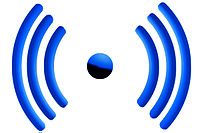 Wi-Fi (
Wi-Fi ("Wi-Fi" is a trademark of the Wi-Fi Alliance and the brand name for products using the IEEE 802.11 family of standards. Wi-Fi is used by over 700 million people, there are over 4 million hotspots(places with Wi-Fi Internet connectivity) around the world, and about 800 million new Wi-Fi devices every year. Wi-Fi products that complete the Wi-Fi Alliance interoperability certification testing successfully can use the Wi-Fi CERTIFIED designation and trademark.

Uses
To connect to a WiFi LAN, a computer has to be equipped with a wireless network interface controller. The combination of computer and interface controller is called a station. All stations share a single radio frequency communication channel. Transmissions on this channel are received by all stations within range. The hardware provides no indication to the sender about whether the transmission was delivered and is therefore called a best-effort delivery mechanism. A carrier wave is used to transmit the data in packets, referred to as Ethernet frames. Each station is constantly tuned in on the channel, so each transmission is noticed. In order to determine whether the channel is free, the carrier wave can be sensed by the hardware; if not present the channel is free for transmission.
=Internet access
A Wi-Fi enabled device such as a personal computer, video game console, smartphone or digital audio player can connect to the Internet when within range of a wireless network connected to the Internet. The coverage of one or more (interconnected) access points — called hotspots — can comprise an area as small as a few rooms or as large as many square miles. Coverage in the larger area may depend on a group of access points with overlapping coverage. Wi-Fi technology has been used in wireless mesh networks, for example, in London, UK.[16]
In addition to private use in homes and offices, Wi-Fi can provide public access at Wi-Fi hotspots provided either free-of-charge or to subscribers to various commercial services. Organizations andbusinesses - such as those running airports, hotels and restaurants - often provide free-use hotspots to attract or assist clients. Enthusiasts or authorities who wish to provide services or even to promote business in selected areas sometimes provide free Wi-Fi access. As of 2008 more than 300 metropolitan-wide Wi-Fi (Muni-Fi) projects had started.[17] As of 2010 the Czech Republic had 1150 Wi-Fi based wireless Internet service providers.[18][19]
Routers that incorporate a digital subscriber line modem or a cable modem and a Wi-Fi access point, often set up in homes and other premises, can provide Internet access and internetworking to all devices connected (wirelessly or by cable) to them. With the emergence of MiFi and WiBro (a portable Wi-Fi router) people can easily create their own Wi-Fi hotspots that connect to Internet viacellular networks. Now iPhone, Android, Bada and Symbian phones can create wireless connections.[20]
One can also connect Wi-Fi devices in ad-hoc mode for client-to-client connections without a router. Wi-Fi also connects places that would traditionally not have network access, for example kitchens and garden sheds.

No comments:
Post a Comment